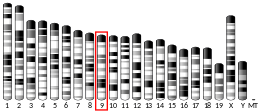RASSF1
Ras association domain-containing protein 1 is a protein that in humans is encoded by the RASSF1 gene.
Function
This gene encodes a protein similar to the RAS effector proteins. Loss or altered expression of this gene has been associated with the pathogenesis of a variety of cancers, which suggests the tumor suppressor function of this gene. The inactivation of this gene was found to be correlated with the hypermethylation of its CpG-island promoter region. The encoded protein was found to interact with DNA repair protein XPA. The protein was also shown to inhibit the accumulation of cyclin D1, and thus induce cell cycle arrest. Seven alternatively spliced transcript variants of this gene encoding distinct isoforms have been reported.[5]
Interactions
RASSF1 has been shown to interact with:
Pathology
Cervical cancer is known to be one of the most severe forms of cancer and is frequently associated with human papilloma virus (HPV).[12] A few studies have been done to investigate the relationship between cervical cancers and RASSF1A, an isoform of RASSF1 that has been shown to suppress the proliferation in tumor cells.[13] Through these studies, it was found that RASSF1A is commonly inactivated in adenocarcinomas (ACs) due to hypermethylation of the promoter region.[12] However, this is not observed in squamous cell carcinomas (SCC) of the cervix, though they can be associated with HPV as well. It was found that RASSF1A was silenced in cancer cells when the promoter region was hypermethylated.[14] It is speculated that cancer subtypes may develop due to the inverse relationship of RASSF1A and HPV. RASSF1A promoter hypermethylation and oncogenic HPV were detected in ACs, but SCCs displayed a high level of HPV DNA and no RASSF1A promoter methylation. Another study used Hela cells to study the potential therapeutic effects of RASSF1A.[13] Hela cells are a line of cells that are derived from cervical cancer cells and are used in scientific research. When Hela cells were generated with RASSF1A expression, the growth of these cells decreased when compared to cells without RASSF1A expression. The rate of apoptosis in those cells had also increased with RASSF1A expression. Through these studies, it was indicated that RASSF1A expression could induce apoptosis and regulate proliferation to suppress tumors, making it a potential therapeutic mechanism for cervical cancers.[13]
References
- GRCh38: Ensembl release 89: ENSG00000068028 - Ensembl, May 2017
- GRCm38: Ensembl release 89: ENSMUSG00000010067 - Ensembl, May 2017
- "Human PubMed Reference:". National Center for Biotechnology Information, U.S. National Library of Medicine.
- "Mouse PubMed Reference:". National Center for Biotechnology Information, U.S. National Library of Medicine.
- "Entrez Gene: RASSF1 Ras association (RalGDS/AF-6) domain family 1".
- Rabizadeh S, Xavier RJ, Ishiguro K, Bernabeortiz J, Lopez-Ilasaca M, Khokhlatchev A, Mollahan P, Pfeifer GP, Avruch J, Seed B (Jul 2004). "The scaffold protein CNK1 interacts with the tumor suppressor RASSF1A and augments RASSF1A-induced cell death". The Journal of Biological Chemistry. 279 (28): 29247–54. doi:10.1074/jbc.M401699200. PMID 15075335.
- Song MS, Song SJ, Kim SY, Oh HJ, Lim DS (Jul 2008). "The tumour suppressor RASSF1A promotes MDM2 self-ubiquitination by disrupting the MDM2-DAXX-HAUSP complex". The EMBO Journal. 27 (13): 1863–74. doi:10.1038/emboj.2008.115. PMC 2486425. PMID 18566590.
- Vos MD, Ellis CA, Bell A, Birrer MJ, Clark GJ (Nov 2000). "Ras uses the novel tumor suppressor RASSF1 as an effector to mediate apoptosis". The Journal of Biological Chemistry. 275 (46): 35669–72. doi:10.1074/jbc.C000463200. PMID 10998413.
- Dallol A, Agathanggelou A, Fenton SL, Ahmed-Choudhury J, Hesson L, Vos MD, Clark GJ, Downward J, Maher ER, Latif F (Jun 2004). "RASSF1A interacts with microtubule-associated proteins and modulates microtubule dynamics". Cancer Research. 64 (12): 4112–6. doi:10.1158/0008-5472.CAN-04-0267. PMID 15205320.
- Liu L, Vo A, McKeehan WL (Mar 2005). "Specificity of the methylation-suppressed A isoform of candidate tumor suppressor RASSF1 for microtubule hyperstabilization is determined by cell death inducer C19ORF5". Cancer Research. 65 (5): 1830–8. doi:10.1158/0008-5472.CAN-04-3896. PMID 15753381.
- Ortiz-Vega S, Khokhlatchev A, Nedwidek M, Zhang XF, Dammann R, Pfeifer GP, Avruch J (Feb 2002). "The putative tumor suppressor RASSF1A homodimerizes and heterodimerizes with the Ras-GTP binding protein Nore1". Oncogene. 21 (9): 1381–90. doi:10.1038/sj.onc.1205192. PMID 11857081.
- Cohen Y, Singer G, Lavie O, Dong SM, Beller U, Sidransky D (2003). "The RASSF1A tumor suppressor gene is commonly inactivated in adenocarcinoma of the uterine cervix". Clinical Cancer Research. 9 (8): 2981–4. PMID 12912945.
- Feng L, Li J, Yan LD, Tang J (2014). "RASSF1A suppresses proliferation of cervical cancer cells" (PDF). Asian Pacific Journal of Cancer Prevention. 15 (14): 5917–20. doi:10.7314/apjcp.2014.15.14.5917. PMID 25081722.
- Li JY, Huang T, Zhang C, Jiang DJ, Hong QX, Ji HH, Ye M, Duan SW (2015). "Association between RASSF1A Promoter Hypermethylation and Oncogenic HPV Infection Status in Invasive Cervical Cancer: a Meta-analysis". Asian Pacific Journal of Cancer Prevention. 16 (14): 5749–54. doi:10.7314/apjcp.2015.16.14.5749. PMID 26320446.




